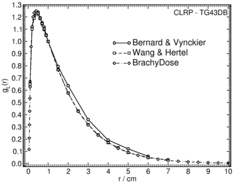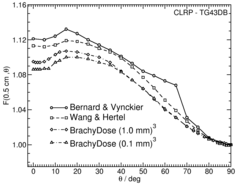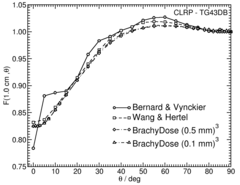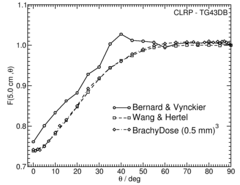

Source Description:
The dimensions for the OptiSeed 1,2 are taken from the study by Bernard and Vynckier. Encapsulation for the OptiSeed is made of bio-compatible polymer (the exact polymer is unknown and assumed to be polyethylene) with inner and outer diameters of 0.400 mm and 0.800 mm, respectively. The ends are sealed with a 0.600 mm long cylindrical piece of polymer (diameter 0.400 mm). The ends are formed into spherical ``cups''. In this study the cups are assumed to be air filled spheres that are 0.400 mm in diameter and have their centers shifted 2.35 mm from the center of the source. Directly adjacent to the end cups are 0.700 mm long and 0.400 mm diameter polymer cylinders (assumed to be polystyrene) with 103 Pd uniformly distributed throughout. The amount of 103 Pd present in the polymer is assumed to be negligible. At the center of the source there is a 2.00 mm long Au cylinder with an outer diameter just larger than the inner diameter of the polymer tube (the gold marker is assumed to have a diameter of 0.450 mm). The space between the polymer cylinders and Au marker is assumed to be air. The overall source length is 5.00 mm and the active length is 3.80 mm.
Dose Rate Constant - Λ :
Dose rate constants, Λ , are calculated by dividing the dose to water per history in a (0.1 mm) 3 voxel centered on the reference position, (1 cm,Π/2), in the 30x30x30 cm 3 water phantom, by the air kerma strength per history (scored in vacuo ). As described in ref. 3 , dose rate constants are provided for air kerma strenth calculated using voxels of 2.7x2.7x0.05 cm 3 (WAFAC) and 0.1x0.1x0.05 cm 3 (point) located 10 cm from the source. The larger voxel size averages the air kerma per history over a region covering roughly the same solid angle subtended by the primary collimator of the WAFAC 4,5 at NIST used for calibrating low-energy brachytherapy sources and is likely the most clinically relevant value. The small voxel serves to estimate the air kerma per history at a point on the transverse axis.
| Author | Method | Λ (cGy h-1 U-1) | Abs. Uncertainty |
| R. E. P. Taylor, D. W. O. Rogers 6 | WAFAC | 0.669 | 0.002 |
| R. E. P. Taylor, D. W. O. Rogers 6 | point | 0.670 | 0.002 |
| S. Bernard, S. Vynckier 1 | TLD | 0.720 | 0.04 |
| S. Bernard, S. Vynckier 1 | point (MCNP) | 0.712 | 0.04 |
| Z. Wang, N.E. Hertel 2 | point (MCNP) | 0.665 | 0.01 |
| Z. Wang, N.E. Hertel 2 | TLD | 0.675 | 0.05 |
Radial dose function - g(r):
The radial dose function, g(r), is calculated using both line and point source geometry functions and tabulated at 36 different radial distances ranging from 0.05 cm to 10 cm. Fit parameters for a modified polynomial expression are also provided 7 .
| Fitting coefficients for g L (r) = (a 0 r -2 + a 1 r -1 +a 2 + a 3 r +a 4 r 2 + a 5 r 3 ) e -a 6 r | ||||||||
| Fit range | Coefficients | |||||||
| r min (cm) | r max (cm) | a 0 / cm 2 | a 1 / cm | a 2 | a 3 / cm -1 | a 4 / cm -2 | a 5 / cm -3 | a 6 / cm -1 |
| 0.10 | 10.00 | 7.2368E-04 | -1.2942E-01 | 1.8649E+00 | 1.3182E-01 | -3.7938E-02 | 2.6165E-03 | 6.0580E-01 |
Anisotropy function - F(r,θ):
Anisotropy functions are calculated using the line source approximation and tabulated at radii of 0.1, 0.15, 0.25, 0.5, 0.75, 1, 2, 3, 4, 5, 7.5 and 10 cm and 32 unique polar angles with a minimum resolution of 5° . The anisotropy factor, φan (r), was calculated by integrating the solid angle weighted dose rate over 0° ≤ ϑ ≤ 90° .
References:
1. S. Bernard, S. Vynckier, Dosimetric study of a new polymer encapsulated 103 Pd seed, Phys. Med. Biol., 50 , 1493--1504, 2005
2. Z. Wang, N.E. Hertel, Determination of dosimetric characteristics of OptiSeed a plastic brachytherapy 103 Pd source, Appl. Radiat. Isotopes, 63 , 311--321, 2005
3. R. E. P. Taylor et al , Benchmarking BrachyDose: voxel-based EGSnrc Monte Carlo calculations of TG--43 dosimetry parameters, Med. Phys., 34 , 445 -- 457, 2007
4. R. Loevinger, Wide-angle free-air chamber for calibration of low--energy brachytherapy sources, Med. Phys., 20 , 907, 1993
5. S. M Seltzer et al , New National Air-Kerma-Strength Standards for 125 I and 103 Pd Brachytherapy Seeds, J. Res. Natl. Inst. Stand. Technol., 108 , 337 -- 358, 2003
6. R. E. P. Taylor, D. W. O. Rogers, An EGSnrc Monte Carlo-calculated database of TG-43 parameters, Med. Phys., 35 , 4228--4241, 2008
7. R. E. P. Taylor, D. W. O. Rogers, More accurate fitting of 125 I and 103 Pd radial dose functions, Med. Phys., 35 , 4242--4250, 2008
Carleton Laboratory for Radiotherapy Physics
December 17 2007.



